For Vanity’s history up to 2005, go here.
The Things You Can Buy on eBay
Late one night, unable to sleep, I thought it would be a good idea to search through e-Bay looking for another Mirror dinghy for my sons. Just as the keyboard started to distort and shimmer before my eyes, I came across and advertisement which went along the lines of “40 foot, 94 year old timber Tasmanian yacht starting bid of $1000”. The accompanying description was brutally honest, noting that even though she had sound Huon pine planking, an entire rebuild was required.
After trying not to think about her I relented and, prepared for a 10-year backyard rebuild, put in a bid. This may or may not have been the same night – my recollections are a bit fuzzy. The only other bidder pulled out first so I picked her up for about $3750 (only just short of my maximum bid) probably equivalent to the value of her lead ballast. This was only slightly above the $3300 it cost to truck her up to Brisbane.
When I saw the photo, I thought she was a boat I saw in Trade-A-Boat back in about 1991-2. Back then I persuaded my cousin John Virtue to look at her, but as he described her as “a chopper-gunned nightmare” and I was not in the mood for a full restoration at the time, I gave her a miss. As it turned out Vanity was not the boat, which has since surfaced (figuratively speaking at least).
Her New Home (For a While at Least)
After purchase, I had her shipped to Sampson Marina by All Boat Transport, who did an excellent job, keeping well supported and her tired old hull in one piece, complete with Pittwater water and the assorted archaeological treasures mentioned below. Having found that the slipway trolley I was going to use to support her in the back yard on Coochie was beyond repair, and a replacement was going to cost over $5,000 I decided to spend the money, along with a lot more, on getting her hull “a few” ribs replaced professionally by Peter Kerr at Deagon Slipways. Eventually after deciding that life was too short for a 10-year rebuild, and finding out that nearly all of the ribs were compost, I decided to get Peter to do the full restoration. The decision was helped by the realisation of how old my sons (and I) would be when I finished.
As she has been much modified over her life and I was not about to cut out 8′ to return her to original size, I was happy to put in a gaff cutter rig rather than the original gaff sloop. This also has the advantage of being able to ship the 5′ bowsprit to reduce mooring requirements. Either way she was to wear a gaff rig.
And so the fun began. The aim of the restoration was to restore her back to as near to her original appearance as possible, with the underlying rule that anything structurally sound should remain, rather than end up with the type of “restoration” where only the lead ballast remains (and has probably been re-cast). This is for two very good reasons:
- Preservation of a historical record; and
- Spending as little as possible.
What Sort of 40 Footer Do You Get for $3750?
As you can see below, she was not exactly in immaculate condition, having spent a fair amount of time floating (just) on her mooring with the cockpit removed and her interior open to the elements. Based on the number of fused chisel conglomerates on board, several restoration “starts” had occurred, with the tools being left on board for when the work could continue. Obviously it never did get much past putting the tools on board. In hindsight (you’ll see that word a lot), had I not handed her over to Deagon Slipways I would probably have just added more tools to the archaeological record.

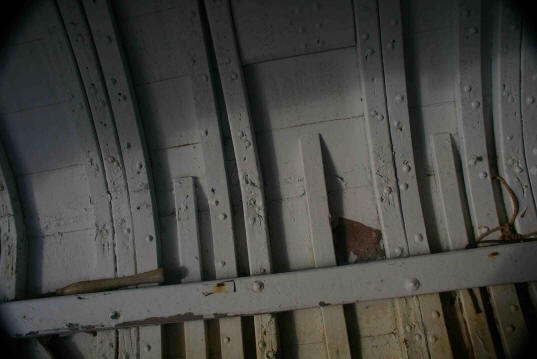
Lots of broken ribs
You can never have enough ribs. Such a pity half of them end along the same plank join, where the originals had already split. In this case there was nothing holding the two planks together for over a metre except paint and slime.
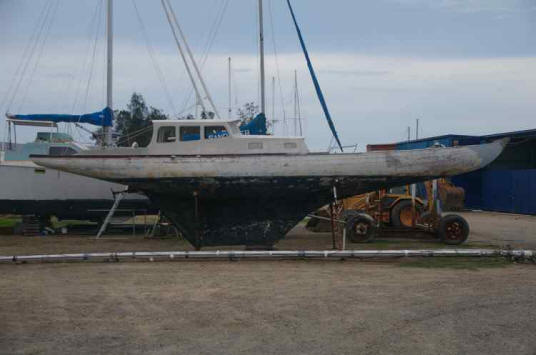
The picture above, besides showing off her “retro” 1970s deck house (now resident on a plywood motorboat in Cabbage Tree Creek) shows the extent of lengthening. She has had 7’4″ added overall and the keel shifted forward, lengthened and deepened with more ballast. Apparently her old bow sat in Lucas’s yard for many years after she was lengthened (it might have come in handy one day). Given the extent of alteration, she is not much of a “one design” anymore but still a great hull shape and lots of history.
After debating the merits of floating her the entire length of Moreton Bay, I decided discretion was the better part of valour and had her loaded yet again on to a truck for delivery to Deagon Slipways. The photos below show what happens when the truck driver, from a different transport company, with obviously less than stellar brainpower thinks “Hmm. Gees it’s wet today. I think I’ll park on that large green patch with the mangrove tree growing out of it”. Thanks to the E-Gen driver, who just happened to be passing by after fuelling up a trawler, for towing her out.
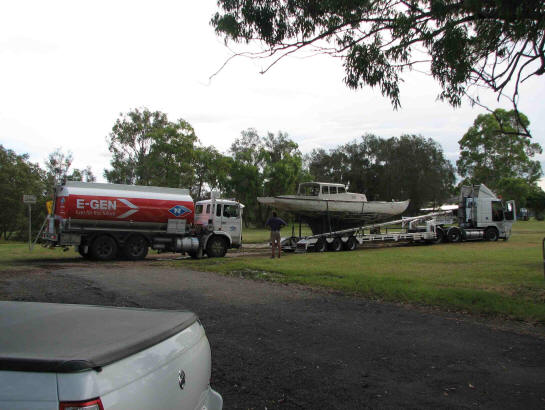
One hour of crane standby later she was ready for takeoff.
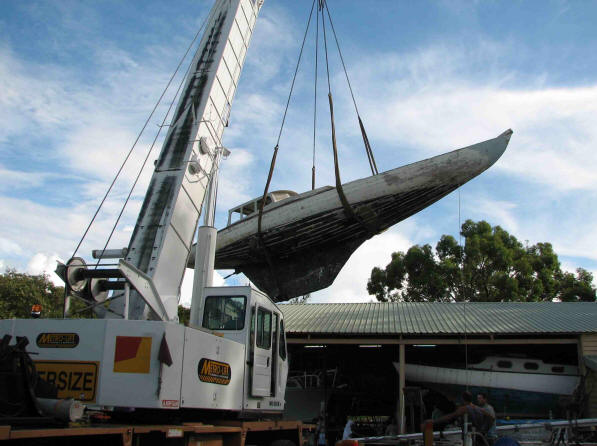
Vanity was eventually safely ensconced in the Kerr’s shed. Pete and the boys removed the old deck and a mass of ply which had been glued into the bow in an attempt to hold the hood ends together. The planking was in good condition considering her age, but the deck was knackered Fortunately many of the deck beams were sound. Some of the ribs that seemed sound were to brittle to re-fasten so have been replaced. Pictures below show the deck removed ready for re-ribbing
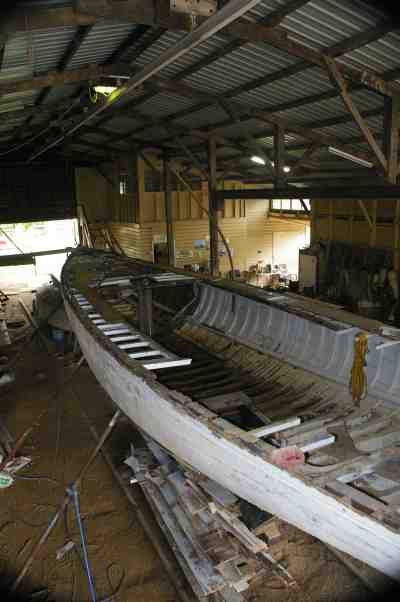
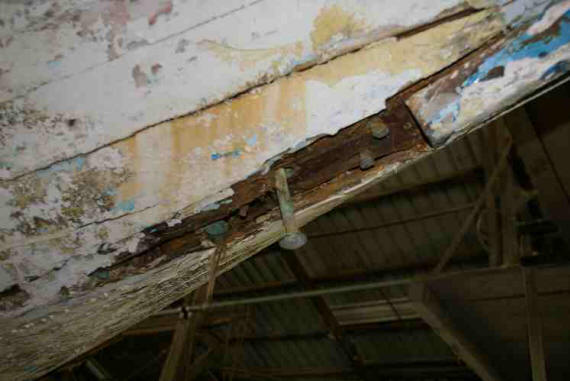
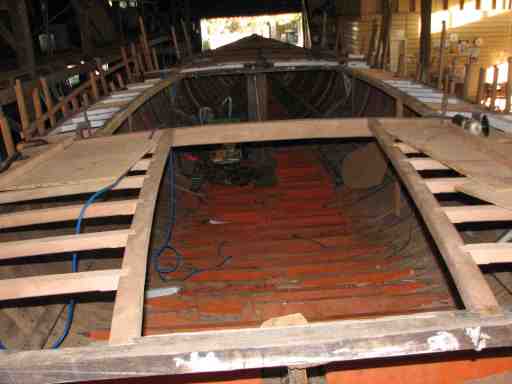
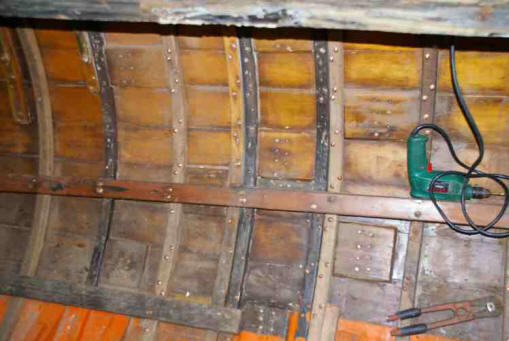

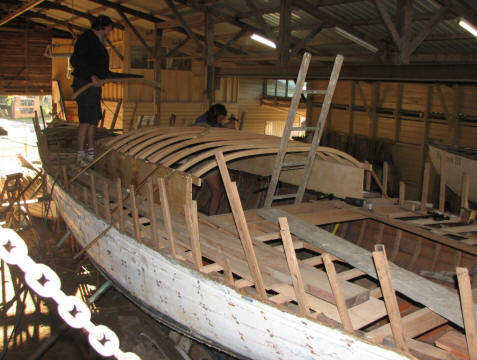
Vanity’s cabin sides laminated out of three layers of Huon Pine salvaged from a hydro dam, with the cabin top beams (white beach) in place.
Based on the spar dimensions, location and fittings, and assuming a headsail hoisted to the top of the forestay, with no overlap, she appears to have had a sail area of about 95 m2 (1030 ft2), or about 1.5 times the original 667 ft2 in Hand’s original design. This makes sense, assuming she was proportionally ballasted when lengthened to 1.2 times her original length. As the centre of effort for a range of topsails, from sensible to very un-sensible, is about the same as the centre of effort for the working rig, it is is possible to get some serious light weather sail without upsetting the steering (just the righting moment and budget). The sails (main, staysail, jib and topsail) were made by Gary Saxby, of UK Halsey Sails in Brisbane. The main is emblazoned with her old number “4” as it appears in her 1912 photo.
After a long process of tracking down fittings from old photographs and form similar boats, such as a series of Buzzards Bay 30s restored by French and Webb in the Belfast, Maine, USA Vanity’s equipment list and sail plan were finalised.
Peter and crew put together a spectacular Huon pine cabin and interior (below). The interior is fairly simple with just some cupboards for a small camping stove and stores and plate racks. No lead light cabinets no buttoned leather, just gleaming Huon pine. Pete also made up the patterns for the various castings.
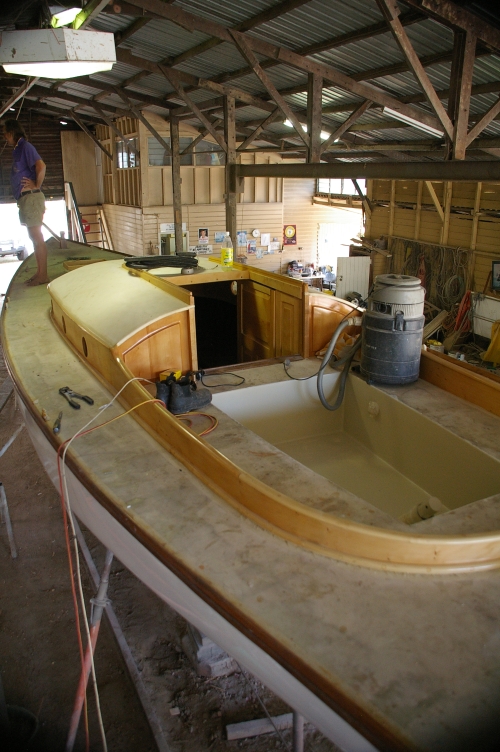
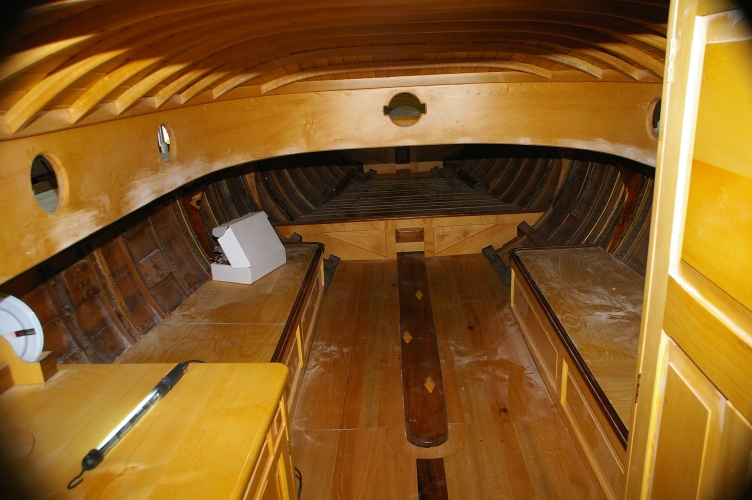
She has a large area for storage of bulky but light objects in the bow, with a large (at least in X and Y dimensions) V-berth aft to the mast. The cabin has full sitting headroom with two very long saloon berths. Aft of these is the galley and Nav station (i.e. a seat to sit down and look at charts). Alas no room for a plasma-screen TV, 19″ GPS displays, RADAR screens, individual tension readouts for each batten and 3D side-scanning sonar . Her electronics will be limited to a wireless log and sounder to keep track of her predicted spectacular speed and help avoid lumpy bits of Australia, and a radio. The head, complete with restored Baby Blake (courtesy of Ivan and Ann Holm of Laurabada) is in the aft of the cabin on the starboard side. There is a large (again mostly in two dimensions) single quarter berth on either side (starboard primarily for storage as access is via the head) The motor, a electric Thoosa 9000RG is under the small bridge deck at the front of the cockpit.
I have a Rippingille stove – “a formidable and hideous piece of ironmongery” (Erskine Childers “Riddle of the Sands”), which I was hoping to place in her galley. Recent firing tests, however, suggest that unless I want to cook “Duck a la Kero” I will need to find a cleaner-burning fuel.
Below are the plans Drawn up by Matthew Morgan of Commercial Naval Architects.
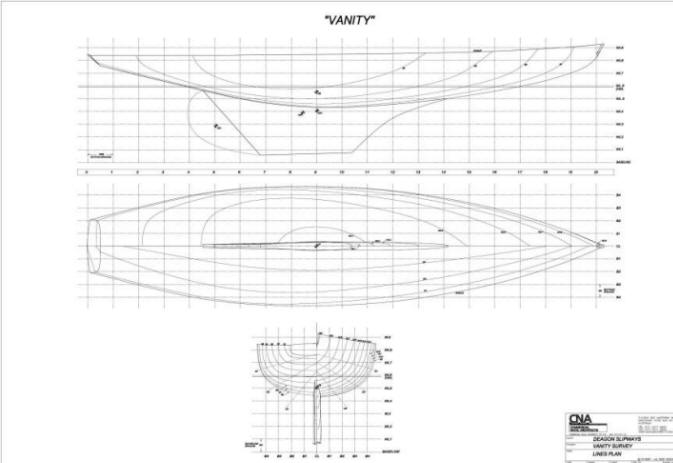
Vanity was launched in to Cabbage Tree Creek on 18 October 2009 awaiting her spars, rigging and blocks. The blocks were hand-made with Huon pine shells by Nick White Conrad Blocks and are works of art.
Over the next few months vanity was slowly finished and her mast rigged and stepped on 7 June 2010. After a period of fairly relaxed pace, due the slipways other commitments, a frantic effort was put in to get Vanity ready for the Vintage Yacht Regatta at the QCYC on 12 June. So frantic was the effort that her first sail with a gaff rig, since 1930, was the first race on Saturday morning.
Crewed by tactician Jane “Granny” Virtue (mum), mainsheet and runners Keith Virtue (cousin) and foredeck hand Liam Virtue (number 2 son), she lived up to the promise of her large (well-balanced) sail plan and slim lines, cruising along at great speed despite the light breeze. Apart from some teething trouble with the forestays and gaff saddle, and a jammed outhaul (responsible for a terribly baggy main later in the day) we went well and came fist in our division (albeit of 3 boats) and left for dead a number of boats which should have been much faster. I would like to think it was due to my supreme skippering and her fantastic speed, but I think it had more to do with the fluky breeze. The next day, due to the slipping forestay and fresh breezes, we had to be content with a cruise under stays’l.

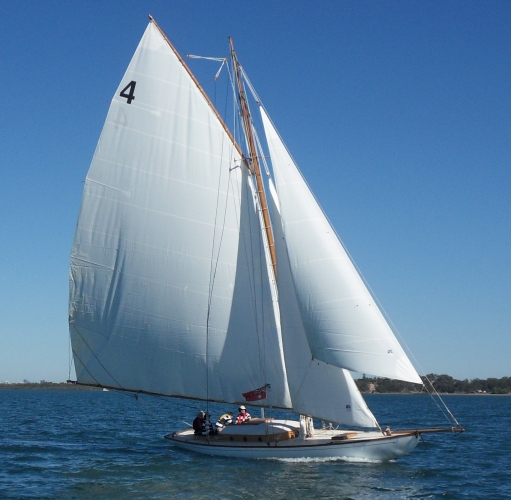
A couple of weeks later Peter Kerr, Keith Virtue, Euan McDonald and I took her out, with modified gaff saddle and hounds, in 15 knots of southeasterly. With full working sail she happily belted along at 8-9 knots, just wetting the rail and with about the right amount of weather helm. It was a great relief to know I got the sail plan right. Luckily, sail maker Garry Saxsby (UK-Halsey Brisbane) was not there to see the hideous shape we still had in the main due to the still jamming outhaul and loose gaff lacing. Peter, Keith and Garry (I was back in Hobart) took her out a few weeks later in a QCYC winter series race and finally fixed up the sails. By all reports she went even faster (third over the line in Div 2).

Vanity sat patiently in Cabbage Tree Creek until February 2011, avoiding major damage from runaway boats in local flooding and debris in the bay after the Brisbane floods, awaiting sufficient funds to truck her down to Hobart. This finally happened just in time for her to be relaunched into her home waters a week before the 2011 Wooden Boat Festival.
“Why Hobart?” you ask, “When you live on Coochiemudlo Island?”. Life is never that simple. During a visit to Hobart in October 2006 for a holiday and to do some Vanity research, Liz and I fell in love with the River Derwent and decided to head south in 2008. As a result Vanity returned to her birth place of 100 years before.